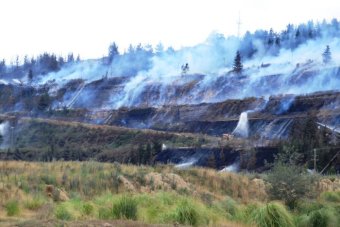A joint report from three prominent statisticians has concluded that there is “moderate evidence” that mortality rates increased in the Latrobe Valley during, and shortly after, the Hazelwood mine fire.
The report was commissioned by the inquiry board tasked by the Government to investigate the blaze.
Based on historical data the statisticians expected to see 250 deaths in the Latrobe Valley between February and June last year.
But they found there were 285 deaths – the chance of that occurring randomly is 60 to 1.
The report also found strong evidence of emergency hospital admissions as a result of the fire.
endy Farmer, the president of the community group, Voices of the Valley, said she felt like the inquiry had answered the community’s questions about the fire’s health risks.
“We asked the question, did people die in this fire? And it’s becoming pretty clear now they did,” she said.
Former chief health officer questioned on Hazelwood study
Earlier in the day, Victoria’s chief health officer Rosemary Lester defended accusations she influenced a separate report on the fire.
The inquiry was shown emails from Dr Lester asking for changes to a university report examining deaths in the Latrobe Valley during the mine fire.
However, Dr Lester said she did not remember asking for changes to the University of Melbourne report.
She faced sustained questioning from counsel assisting Peter Rozen on the second day of the inquiry in Morwell, in Victoria’s east, into the coal mine fire that last year burnt for 45 days.
Dr Lester had contracted the university to review work by Professor Adrian Barnett from Queensland University of Technology, who found it was highly probable the mine fire contributed to 11 deaths.
Mr Rozen questioned Dr Lester about why she personally oversaw a contract that was fairly small.
He also asked if it was appropriate for her to be involved, given that she had faced criticism for her handling of the mine fire response.
Dr Lester said the fire had created quite unusual circumstances and she felt she should take carriage of the project herself.
She told the inquiry she had not worked with university researcher Dr Louisa Flander before that project, but went to Melbourne University because of its good reputation.
Dr Lester told the inquiry she could not remember asking for changes to Dr Flander’s report, but the inquiry was later shown an email Dr Lester had sent her.
It asked for Dr Flander to include additional information in her report.
‘Personal view’ was deaths decreased in Morwell
Mr Rozen asked Dr Lester if she had been after a report from the university that reflected her view that the mine fire did not contribute to deaths.
“Well, I had a personal view that the deaths actually decreased in Morwell,” she said.
But she defended the university saying “no independent researcher would make changes they can’t support”.
Yesterday, the hearing was shown a series of emails between Dr Flander and officials from the health department.
The department suggested a number of changes to the wording and content of Dr Flander’s report, including changing one of her conclusions.
Researcher denies findings were ‘collaborative’
In her evidence, Dr Flander defended the independence of her work saying she did not “copy and paste suggestions” from the department.
She rejected a suggestion her reports were “collaborative” with the department, rather than independent of it.
Dr Flander was also asked about the speed with which she took up suggestions from the department.
The inquiry was shown an email she sent to a health official saying she would incorporate all of its suggestions in her final report.
That email was sent just 38 minutes after the department had sent through its recommendations.
Dr Flander told the inquiry she considered the recommendations for a lot longer than 38 minutes and said she did not include all the department’s suggestions in her work.


